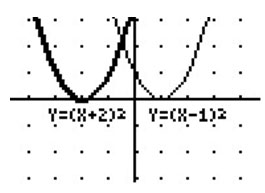
What happens if we change “h” in f(x) = a(x – h)2 + k?
The parameter “h” translates (moves) the graph horizontally.
Describe the effect on the graph of y = (x − 1)2 if the equation is changed to y = (x + 2)2 ?
Solution
If y = (x – 1)2 ⇒ h = 1.
This is the parent graph translated one unit to the right, since h = 1 and 1 > 0.
If y = (x + 2)2 = (x − -2) ⇒ h = -2.
This is the parent graph translated two units to the left, since h = -2 and -2 < 0.
Comparing the graphs shows that y = (x − 1)2 is 3 units to the right of y = (x + 2)2.

If the graph of f(x) = 2(x – 3)2 + 1 is to be translated 4 units to the left, what is the equation for the new parabola?
Solution
A translation 4 units to the left is horizontal and affects ONLY the “h” in the equation.
If f(x) = 2(x – 3)2 + 1 ⇒ h = 3.
To translate this graph to the left, you should subtract from “h”.
Starting at 3 and moving to the left 4 units gives you 3 – 4 = -1, so the new “h” is -1.
New equation: f(x) = 2(x – -1)2 + 1 which simplifies to f(x) = 2(x + 1)2 + 1.